ASUS Eee Pad Transformer Review
by Anand Lal Shimpi on April 21, 2011 4:00 AM ESTI've been on a bit of a tablet kick lately, so even if you have dinner with me—tablets are bound to come up (I only break out the SSD conversation for the truly patient). Last week I had the pleasure of having dinner with Tony Tamasi and Jim Black of NVIDIA, and of course—tablets came up.
I've been thinking about device synergy, something I brought up in our PlayBook review. The problem is as follows: if I'm on my desktop with half a dozen tabs open and perhaps a PDF as well, but I decide to switch over to a tablet—there's no quick way that I can transition my reading environment between the devices. What I have to do is sit down on the couch, whip out my tablet, and manually navigate to each website and redownload/open the PDF. What I'd like to do is something along the lines of HP's Touch to Share, but just on a larger scale.
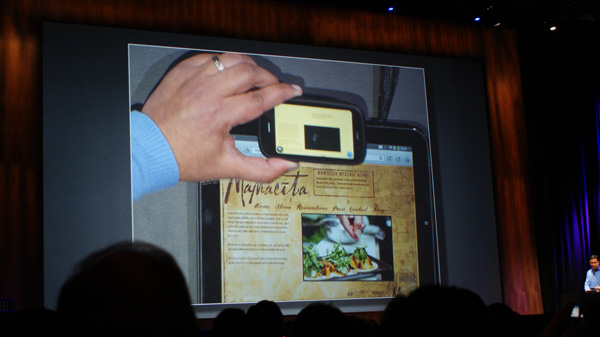
HP demonstrating Touch to Share
I posed this question to Tony when he asked me about future tablet technologies. From Tony (and NVIDIA's perspective), the problem is a non-issue because eventually all computing is done on your smartphone and you simply dock it from one set of input/output devices to the next. At your desk you'll dock your smartphone to a large display, keyboard and mouse. On the go you'll either have your smartphone or dock it into a notebook like chassis. Presumably you'll have a mid-sized display you could tether it to for tablet use as well.
NVIDIA isn't the only company that believes in the future of dockable computing. Earlier this year Motorola released the Atrix, arguably the best overall Android phone on the market today, with an optional laptop dock. While Motorola's docked experience wasn't all that great, treat it as a proof of concept—there's potential here.
You might argue that Motorola's shortcomings with its laptop dock are a result of its unfamiliarity with making PCs; after all Motorola has never shipped a laptop, just smartphones. You might also argue that a PC maker would have an easier time delivering a more polished, functional solution. You might assume that a company like ASUS might be a good candidate for such a thing. You'd be right.
The Eee Pad
ASUS was at the forefront of the netbook revolution thanks to its close partnerships with Intel and Microsoft. ASUS has been all but absent from the smartphone and tablet revolution again, because of its two key partnerships: Intel and Microsoft. Both Intel and Microsoft lay dormant while the smartphone and tablet revolution pick up speed; granted this may all change around Windows 8, but for now it's the truth. If you're a partner of both Intel and Microsoft, you too lay dormant while competitors like Apple, Samsung, Motorola and LG take your cake. After more than enough thumb fiddling, it was ASUS' turn for a slice. The result is this:
Technically it's called the Eee Pad Transformer TF101 thanks to its ability to transform into a netbook/notebook with an optional keyboard dock and ASUS' inability to shy away from long model names. From here on out we'll just call it the Eee Pad.
At a very high level, the Eee Pad is yet another Honeycomb tablet. It's got an NVIDIA Tegra 2 SoC, 1GB of LPDDR2 memory, a WiFi radio, and 16GB of NAND on-board. Delve a little deeper and the story quickly becomes more interesting.
We'll start at the price: $399 for 16GB WiFi. That's $100 cheaper than the equivalent iPad, and $200 cheaper than the lowest priced Xoom. I've often called tablets luxury devices, but ASUS is putting the price pressure necessary on these things for the market to really thrive. While $399 isn't into the "why not?" category just yet, I like where ASUS is headed with this. In other words, I don't believe $399 is the floor here either. Up to now tablets (and smartphones) have been a cash cow for those involved. I don't mind there being premium offerings; I just also want to see something more affordable.
The low price point alone is enough to make the Eee Pad worth considering if you want an Android tablet, but surprisingly enough ASUS didn't sacrifice much in the way of quality to hit it.
The chassis isn't all metal, nor is it soft touch plastic, but that's not to say the feel is bad at all. On the front you've got mostly glass surrounded by a thin strip of metal that wraps around the Eee Pad. Around back there's a textured plastic covering that seems oddly reminiscent of a notebook (the foreshadowing here is quite thick).
The feel is what's most surprising about the Eee Pad. Despite not spending a ton on materials, ASUS managed to build a very comfortable to hold and use tablet. There's a bit of creakyness in the back plastic if you squeeze the Eee Pad, but it's not enough to make the tablet feel cheap. A benefit of not being made of aluminum is I'm not as afraid to set the Eee Pad down on a table as I am the iPad. It feels more rugged, more casual.
| Tablet Specification Comparison | ||||||
| Apple iPad 2 | ASUS Eee Pad | BlackBerry PlayBook | Motorola Xoom | |||
| Dimensions | 241.2mm x 185.7mm x 8.8mm | 271mm x 175mm x 12.95mm | 194mm x 130mm x 10mm | 249.1mm x 167.8mm x 12.9mm | ||
| Display | 9.7-inch 1024 x 768 | 10.1-inch 1280 x 800 | 7-inch 1024 x 600 | 10.1-inch 1280 x 800 | ||
| Weight | 601g (WiFi only) | 675g | 425g | 730g | ||
| Processor | 1GHz Apple A5 (2 x Cortex A9) | 1GHz NVIDIA Tegra 2 (2 x Cortex A9) | 1GHz TI OMAP 4430 (2 x Cortex A9) | 1GHz NVIDIA Tegra 2 (2 x Cortex A9) | ||
| Memory | 512MB | 1GB | 1GB | 1GB | ||
| Storage | 16GB up to 64GB | 16GB + microSD card | 16GB up to 64GB | 32GB + microSD card | ||
| Pricing | $499 up to $829 | $399 | $499 up to $699 | $799 | ||
The Eee Pad has the thickness of an original iPad without the density, so it doesn't feel as fatiguing to hold—partially due to its larger size. It's definitely the largest ARM based tablet I've used, making it suboptimal for porting around town, but it's very nice to use at home. The Eee Pad is like the comfort food of tablets; it's not the most exquisite but it just feels good. My only complaint about the design is thickness. The iPad 2 and new Galaxy Tab have spoiled us here. I suspect we'll get a nicely redesigned version with Kal-El by the end of the year if NVIDIA works hard enough.
When cutting costs the display is usually the first to go, but thankfully our complaints have been heard. Not only has ASUS improved display quality on the notebook side, but the Eee Pad ships with an IPS panel guaranteeing good viewing angles and image quality. The display is a Xoom-like 1280 x 800 and measures 10.1-inches on the diagonal.
ASUS includes two small speakers, one on either side of the display. A volume rocker and power/lock button are both on the left edge of the Eee Pad. On the right side there's a headphone port, mini HDMI out and microSD slot.
The Eee Pad has two cameras: a 1.2MP front facing camera and a 5MP rear camera. There's no flash present.
Along the bottom edge of the Eee Pad is a 40-pin ASUS dock connector, which enables the Transformer part of the Eee Pad experience. ASUS ships the Eee Pad with a 40-pin ASUS dock to USB cable as well as a USB to AC adapter for wall charging.
Charging over USB is ill advised at this point since it'll take somewhere over 16 hours to fully charge the Eee Pad over a standard USB port. ASUS claims this will be fixed with a future software update. I didn't have the time to measure exactly how long a full charge over USB would take; I just measured long enough to know it would be a problem.


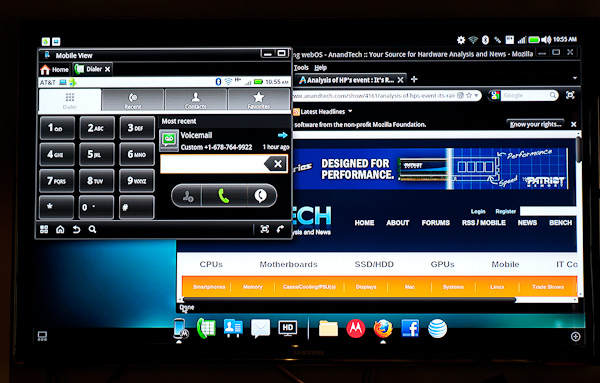
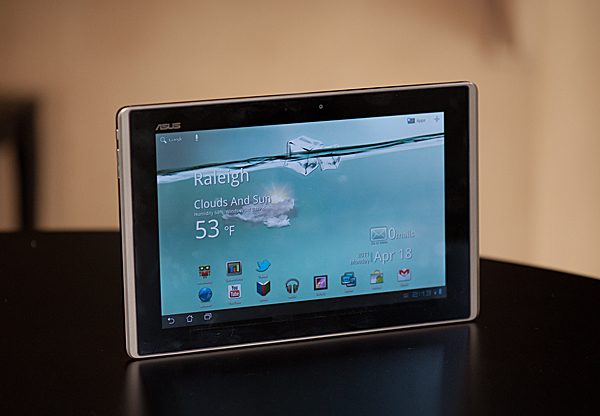
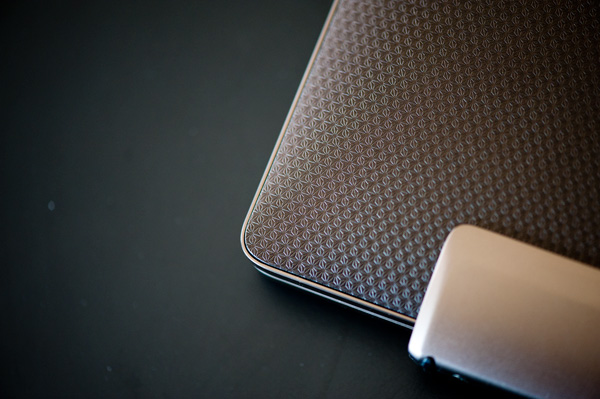
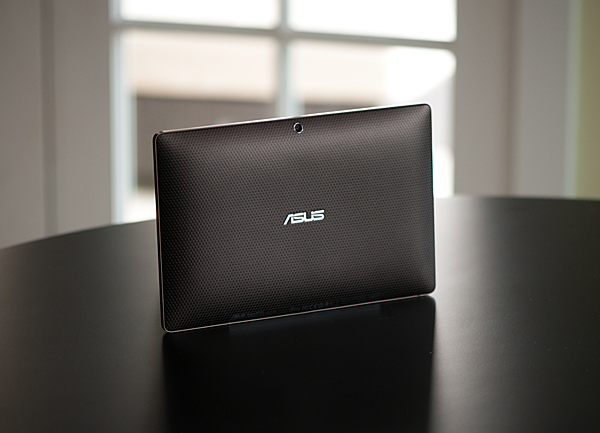
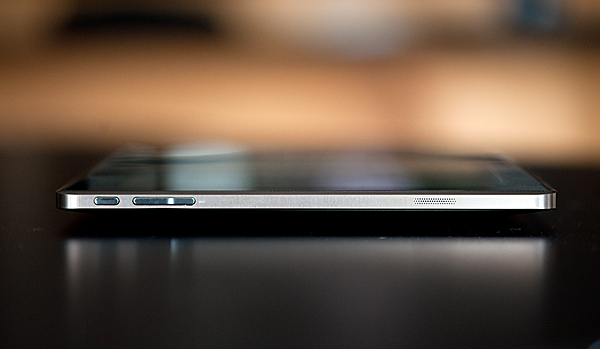

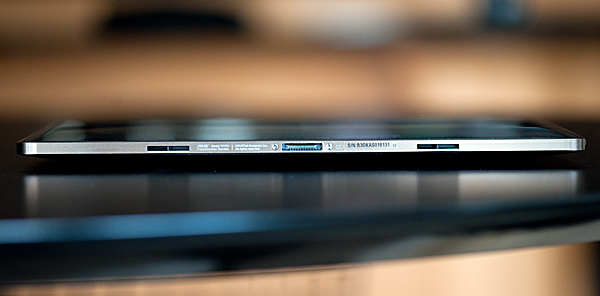









127 Comments
View All Comments
aZUEStablet - Wednesday, July 6, 2011 - link
There is tons of use for it right now... the only issue is that it needs to be supported for a while and asus needs to build enough trust that it will continue to be supported for more that a season.i was pretty impressed when the tablet when it when up on my door step!! i was so stoked on it i spazzed out a little and made a (kind of) dumb video of me hooking it up to my aaxa tech m2 micro projector: http://www.youtube.com/watch?v=N_AFAPJGSLs
xype - Thursday, April 21, 2011 - link
"So why do companies keep introducing tablets with known software issues? I always remember what AMD's Eric Demers once told me: the best way to lose a fight is to not show up."Uhm, you do know that showing up unprepared for a fight only gives you very slightly better chances than not showing up? And that showing up to a _real_ fight might get you killed, while staying at home won't?
This whole talk reminds me of geeks dating. You think by showing up looking like a hobo will give you a chance to woo the other person with your inner values—but it won't. You'll just disqualify yourself from further consideration (at least for a while).
All the companies producing Android tablets would do better to wait a bit, get a haircut, apply some makeup and then try to woo the customers. Right now, they're all just making a bad impression and—as is always the case with Android—spout promises of a better future.
Either Google will really, really increase their development tempo and hire some good designers (which they won't, because they're retarded) and magically overtake Apple, or they'll simply stay that ugly chick that hopes some horny guy will take her home at the end of the night.
Rick83 - Thursday, April 21, 2011 - link
If you're the horny guy, it's better to take home the ugly chick for cheap than wait 2 months until the pretty girl is available only to find out that she won't put out unless you bath her in champagne and diamonds...xype - Thursday, April 21, 2011 - link
Ooor, you work your, get a haircut, some manners and score a score of hot chicks. But that sounds too much like effort and risk, doesn't it? Never been the strong suit of Apple's competitors.medi01 - Thursday, April 21, 2011 - link
BS.Many products out there have superior hardware and features than iStuff.
Not only that, but creator iStuff is the only company out there that dares to deny user free access to his own content. (not able to sync ipod with more than one PC? not able to read stuff from it? "comfortable" isn't it?)
xype - Thursday, April 21, 2011 - link
1) No, not many. At best a few are better in a category or two.2) I have "free access" (whatever that means) to everything on my iPhone and was syncing it with two computers when I had two. Don't blame others for your incompetence.
anishannayya - Thursday, April 21, 2011 - link
Medi01 is talking about the ability to root the hardware. You know, take full functionality and capability of the device that you forked your hard owned money for. In your words, don't blame others for your incompetence (ignorance).Azethoth - Friday, April 22, 2011 - link
Ya know, I am a computer programmer and while I did not mind hacking out some mods for the WoW ui which really needs it, why on earth would I want to do that for a phone? A phone that comes with thousands of apps that do useful things. In other words, it is about the apps. It is not about hacking the OS.So please actually state what it is you get from rooting your phone? What is so important in its guts that you feel ripped off not getting in there and mucking around with it?
evil bob - Friday, April 22, 2011 - link
The ability to strip out all the battery eating bloatware the carrier installed and insists you want running 24/7.Sprint, for example, installs Nascar and Football applications amongst its bloatware that run in the background nearly every phone they currently sell. You can go into the phone settings and turn them off, check again in a couple minutes and they're back up and running again, their bloatware is persistant.
Rooting my Evo 4G and stripping out said bloatware doubled by battery runtime the day I rooted it. Further refinements went into the OS, installation of an app killer and a CPU manager, and now I'm getting 30+ hours out of my smartphone when before in stock form it was lucky to last 6 hours off the battery.
It was well worth the time mucking around with the "guts" to more than triple the battery life.
Sukaflops - Thursday, April 21, 2011 - link
I may not be the biggest fan of IOS devices but you can sync them on 5 authorized computers.